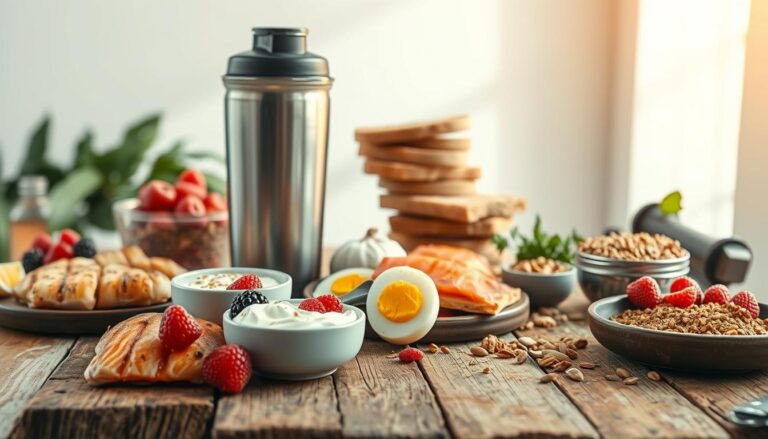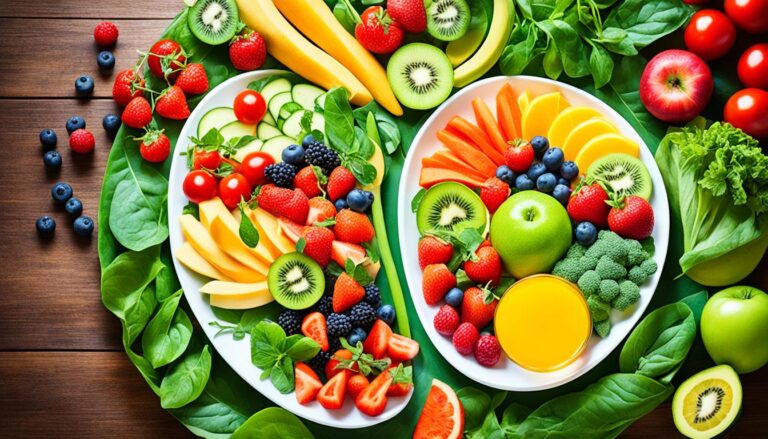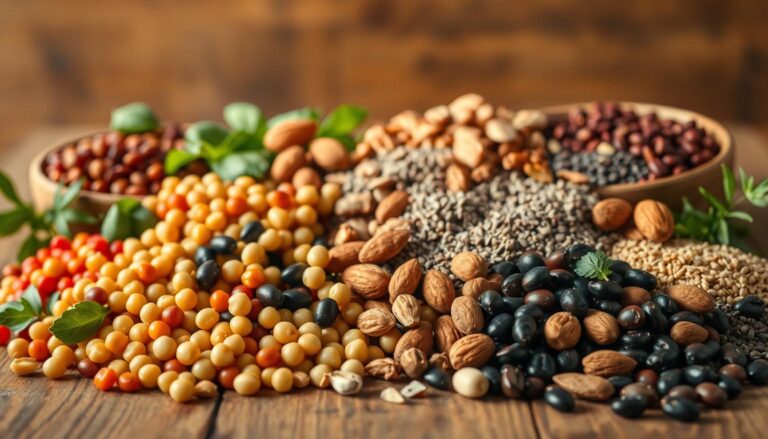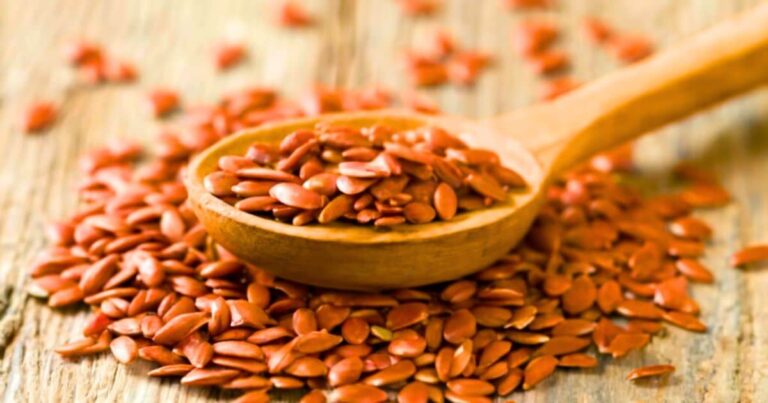Have you ever wondered which foods are actually the best sources of Vitamin B1 and how they can significantly impact your health?
Understanding the vital role of Vitamin B1, also known as thiamine, is crucial for maintaining energy production and nerve function in the body. But where do you find the most potent sources of this essential nutrient within your daily diet?
In this article, we’ll explore the best sources of vitamin b1, uncovering various food groups that are incredibly rich in this essential nutrient. From wholesome grains and nutrient-dense nuts and seeds to protein-packed meats and legumes discover how these foods can enhance your diet.
This guide aims to help you make informed choices about vitamin b1 food sources, ensuring that you consume a balanced and nutritious diet.
Key Takeaways
- Vitamin B1, or thiamine, is essential for energy production and nerve function.
- Whole grains, such as quinoa, brown rice, and oats, are excellent sources of Vitamin B1.
- Nuts and seeds like sunflower seeds and flaxseeds provide significant amounts of this nutrient.
- Legumes such as black beans, lentils, and peas are rich in Vitamin B1.
- Meats, particularly pork and beef, are high in Vitamin B1 content.
Understanding Vitamin B1 and its Benefits
Vitamin B1, also known as thiamine, is a crucial micronutrient that plays an indispensable role in maintaining overall health. Recognizing the importance of thiamine functions helps us better appreciate its myriad benefits. These functions include aiding in energy production by converting carbohydrates into glucose which the body uses for energy.
Additionally vitamin B1 supports proper neurological function ensuring that our nervous system operates efficiently.
Inclusion of vitamin B1 in our diets is vital for cardiovascular health. This vitamin helps to maintain proper heart function and is instrumental in the development and function of muscles within the heart. Moreover, the benefits of vitamin B1 extend to enhancing mental clarity and cognitive functions.
To ensure sufficient intake of thiamine, a well-rounded vitamin B1 sources list is essential. Foods rich in vitamin B1 include whole grains, nuts, seeds, and legumes.
Ensuring a diet that includes these foods is crucial for reaping the numerous health benefits of vitamin B1. Understanding thiamine functions empowers individuals to make informed dietary choices that support their overall well-being.
The following table provides a snapshot of essential vitamin B1 sources:
| Food Source | Vitamin B1 Content mg/100g |
|---|---|
| Sunflower Seeds | 1.48 |
| Pork | 0.98 |
| Black Beans | 0.42 |
| Quinoa | 0.36 |
By incorporating these valuable sources into your diet, you can ensure an adequate intake of vitamin B1, harnessing its full range of health benefits.
Whole Grains: A Rich Source of Vitamin B1
Incorporating thiamine-rich whole grains into your diet is an excellent way to boost your Vitamin B1 intake. Whole grains are not only nutritious but also versatile and easy to prepare, making them a staple in many households.
Quinoa
Quinoa stands out due to its impressive quinoa vitamin b1 content. This ancient grain is not only a complete protein but also a powerhouse of essential vitamins, including Vitamin B1. One cup of cooked quinoa provides a significant portion of the daily recommended intake of thiamine.
Brown Rice
Brown rice is another excellent example of foods high in vitamin b1. Being packed with nutrients, brown rice retains its bran and germ layers, which are rich in thiamine. This whole grain can be easily integrated into various dishes, making it a practical addition to your diet.
Oats
Oats are well-known for their numerous health benefits, including their thiamine content. This versatile grain can be consumed as oatmeal, added to smoothies, or baked into goods to reap the benefits. Including oats in your daily meals ensures a healthy intake of Vitamin B1.
Nuts and Seeds with High Vitamin B1 Content
Nuts and seeds are not only convenient snacks but also incredible sources of essential nutrients, including vitamin B1. Among these, sunflower seeds and flaxseeds have gained recognition for their considerable thiamine content, making them excellent additions to a balanced diet.
Sunflower Seeds
Sunflower seeds are touted for their high nutritional value. A significant aspect of this is their richness in thiamine, also known as vitamin B1. Incorporating these seeds high in thiamine in your diet can support energy metabolism and overall neurological function. Whether sprinkled on salads, blended into smoothies, or enjoyed on their own, sunflower seeds offer an easy way to boost your vitamin B1 intake.
Flaxseeds
Flaxseeds are another powerhouse when it comes to their vitamin b1 content in foods. These small seeds are not only high in omega-3 fatty acids but also packed with thiamine.
Adding flaxseeds to your meals can be as simple as mixing them into yogurt, oatmeal, or baked goods. The dual benefit of omega-3s and vitamin B1 makes flaxseeds an invaluable component of a nutrient-dense diet.
| Seed Type | Vitamin B1 Content mg per 100g | Additional Nutrients |
|---|---|---|
| Sunflower Seeds | 1.48 mg | Vitamin E, Magnesium, Selenium |
| Flaxseeds | 1.64 mg | Omega-3 Fatty Acids, Lignans, Fiber |
Vitamin B1 in Legumes
Legumes are an excellent choice for anyone looking to enhance their intake of Vitamin B1. Among these, black beans, lentils, and peas stand out as particularly rich sources of thiamine.

Black Beans
Black beans are a potent black beans thiamine source, making them a valuable addition to any diet. These legumes are not only rich in Vitamin B1 but also offer a good amount of protein and fiber which support overall health. Incorporate black beans into your meals by adding them to salads, soups, or as a complement to rice dishes.
Lentils
Lentils are another excellent option for those seeking legumes high in vitamin b1. They are versatile and can be used in a variety of dishes, such as stews, curries, and even veggie burgers. Lentils and peas vitamin b1 content make them indispensable for a well-rounded diet.
Peas
Peas, whether fresh or frozen, are packed with Vitamin B1, adding a nutritional boost to any meal. They blend well into a variety of recipes, including stir fries, casseroles, and side dishes. By incorporating peas regularly, you can benefit from their abundance of thiamine along with other essential nutrients.
Meats Rich in Vitamin B1
For those who consume meat, pork and beef are notable additions to the vitamin b1 sources list, offering considerable thiamine content essential for a balanced diet. Understanding the best cuts and preparation methods ensures you retain the maximum nutrient benefits.
Pork
Pork is particularly high in thiamine, making it an excellent choice for bolstering your vitamin B1 intake. Lean cuts like pork tenderloin and loin chops are not only nutritious but also versatile in various recipes. Grilling or baking these cuts can preserve their thiamine content effectively.
Beef
While not as thiamine-rich as pork, beef still contributes significantly to your daily thiamine needs. Cuts such as sirloin, chuck, and round roast offer a good balance of flavor and nutrient content. To maximize the beef and thiamine content, opt for methods like stewing or roasting, which help to maintain the vitamin’s potency.
| Meat Type | Cut | Thiamine Content (mg per 100g) |
|---|---|---|
| Pork | Pork Tenderloin | 1.13 |
| Pork | Loin Chops | 0.96 |
| Beef | Sirloin | 0.06 |
| Beef | Chuck Roast | 0.08 |
Fish and Seafoods as Top Thiamine Sources
For those seeking to boost their thiamine intake incorporating fish and seafood into their diet can be highly beneficial. These foods are among the top vitamin B1 sources providing essential nutrients that support overall health. Understanding which kinds of fish are high in vitamin B1 can help diversify your dietary intake and ensure you get enough of this vital nutrient.
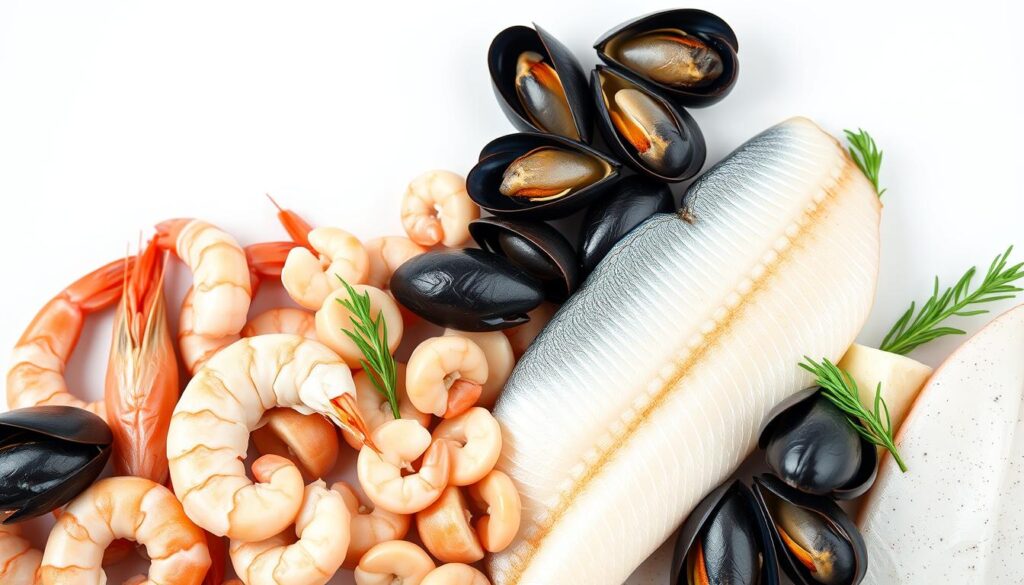
Among the top sources of thiamine in seafood, tuna stands out due to its richness in this vital nutrient. Tuna can be enjoyed in various forms, whether grilled, baked, or used in salads. Another excellent option is salmon, which, aside from being fish high in vitamin b1, also offers omega-3 fatty acids, benefiting both heart and brain health.
Not to be overlooked, oysters and mussels also make the list of top vitamin B1 sources. These seafood delicacies are not only rich in thiamine but also provide zinc and iron, critical for immune function and energy levels.
Here’s a table highlighting the thiamine content in various seafoods:
| Seafood | Thiamine Content (mg per 100g) |
|---|---|
| Tuna | 0.5 |
| Salmon | 0.3 |
| Oysters | 0.15 |
| Mussels | 0.2 |
Incorporating these diverse seafood options into your meals can significantly boost your thiamine intake. By understanding the importance of thiamine in seafood, you can craft a balanced diet that supports your health and vitality.
Dairy Products: Reliable Vitamin B1 Sources
Exploring dairy products can significantly contribute to your daily thiamine intake. Vitamin B1 in milk products like fortified milk can particularly help meet nutritional needs. Milk, being a staple in many American households, serves as an accessible and efficient source of thiamine.
Cheese is another essential item in the dairy category. Varieties such as cheddar, Swiss, and mozzarella are known as cheese thiamine-rich food. Including these in your diet ensures that you receive a daily dose of thiamine while enjoying flavorful meals.
| Dairy Product | Thiamine Content (mg/100g) |
|---|---|
| Fortified Milk | 0.10 |
| Cheddar Cheese | 0.02 |
| Swiss Cheese | 0.03 |
| Mozzarella | 0.01 |
For those looking to diversify their dairy and thiamine intake, incorporating various cheese and milk products is a practical choice. The combination of delectable flavors and essential nutrients makes dairy a reliable source of Vitamin B1, especially crucial for vegetarian diets.
Vegetables Containing Vitamin B1
Vegetables high in vitamin b1 provide essential nutrients for maintaining good health. Noteworthy among them are asparagus and spinach, which stand out due to their significant thiamine content. Including these vegetables in your diet can be an effective way to boost your vitamin B1 intake naturally.
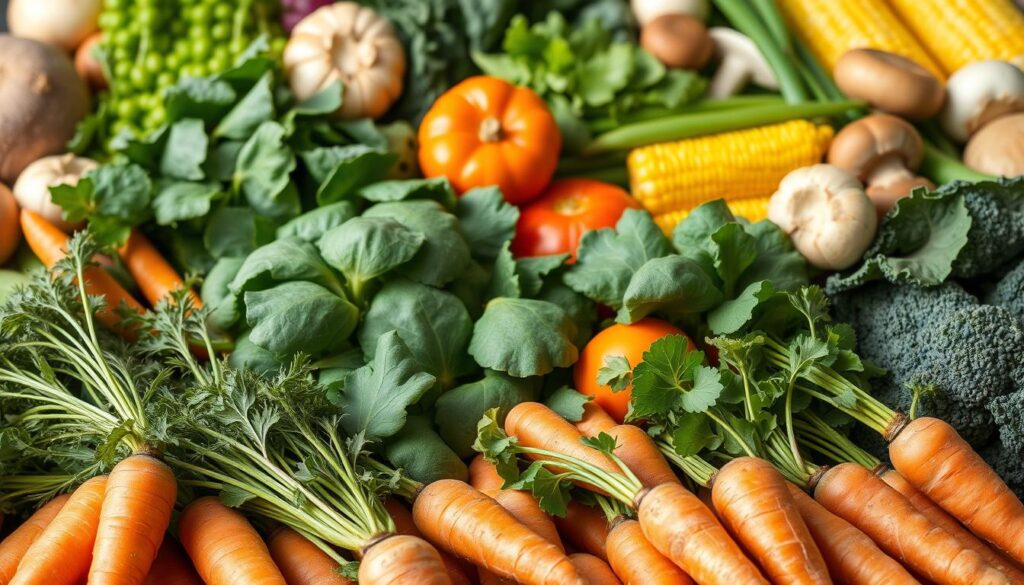
Asparagus
Asparagus thiamine content makes it a standout vegetable in terms of its nutritional profile. This green stalk is not just a spring delicacy but also a powerhouse of various essential vitamins, including vitamin B1. Regular consumption of asparagus can contribute significantly to your daily thiamine requirements.
Spinach
Spinach is another excellent example of spinach vitamin b1 sources. This leafy green is packed with nutrients, and its thiamine content makes it a valuable addition to a thiamine-rich diet. Adding spinach to your meals can help ensure you get enough vitamin B1, while also benefiting from its other vital nutrients.
| Vegetable | Thiamine Content (mg per 100g) |
|---|---|
| Asparagus | 0.14 |
| Spinach | 0.10 |
Vitamin B1 Food Sources for Vegetarians
Addressing the concerns of vegetarians about adequate Vitamin B1 intake is crucial. Fortunately, there are plenty of vegetarian thiamine-rich foods that can help meet dietary requirements efficiently.
Whole grains are excellent vitamin b1 sources for vegetarians, with options like quinoa, brown rice, and oats leading the charge. These grains can be easily incorporated into daily meals, providing a substantial dose of plant-based vitamin b1.
Additionally, various nuts and seeds such as sunflower seeds and flaxseeds are notable vegetarian thiamine-rich foods. They can be enjoyed as snacks or added to salads and shakes, making them versatile ingredients in a vegetarian diet.
Legumes, including black beans, lentils, and peas, are also fantastic sources of Vitamin B1. They can be utilized in a wide array of dishes, from soups to stews, ensuring that vegetarians have ample opportunities to consume this vital nutrient.
Lastly, vegetables like asparagus and spinach are valuable additions to the list of plant-based vitamin b1 sources. These vegetables not only contribute to a nutritious diet but also support overall well-being.
By integrating these foods into everyday meals, vegetarians can successfully maintain adequate Vitamin B1 levels and enjoy a balanced diet.
Vitamins B1 Might Be Missing in Vegan Diets
A vegan diet, while rich in various nutrients, might lack sufficient vitamin B1. For those committed to a plant-based lifestyle, obtaining adequate thiamine is crucial for overall health. Understanding the best strategies to ensure adequate intake involves focusing on thiamine fortified foods and vegan thiamine supplements.
Fortified Foods
Incorporating thiamine fortified foods is a practical approach to meeting daily requirements of this essential nutrient. Fortified cereals, plant-based milk, and nutritional yeast often contain added vitamin B1, making them excellent vitamin b1 sources for vegans.
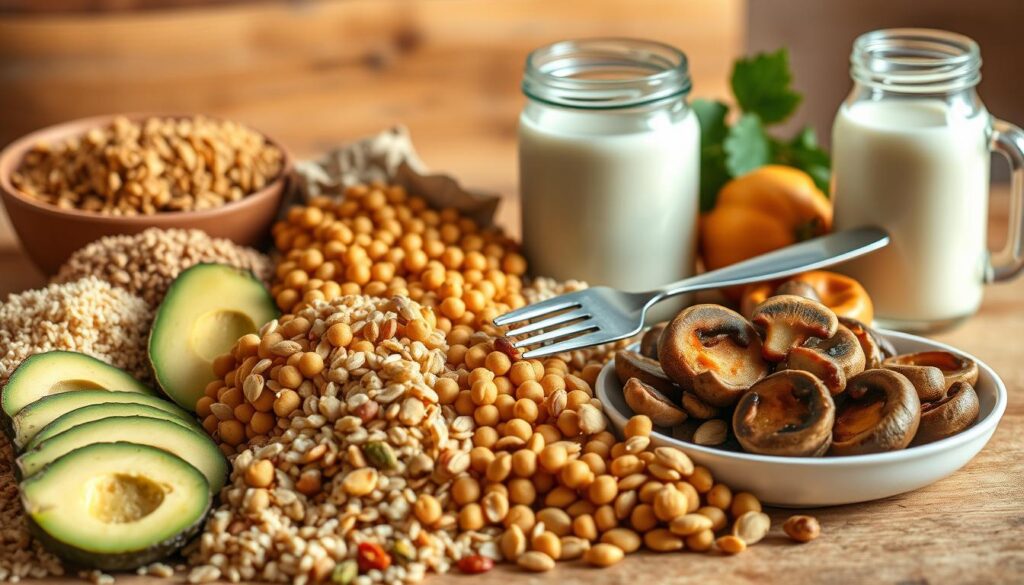
Below is a comparison of popular thiamine fortified foods beneficial for vegans:
| Food Item | Thiamine Content (mg per serving) |
|---|---|
| Fortified Cereal | 1.5 |
| Plant-Based Milk | 1.2 |
| Nutritional Yeast | 0.75 |
Supplements
If fortified foods are insufficient, vegan thiamine supplements are another reliable option. These supplements can be found in various forms such as tablets, capsules, and even liquid drops. It is recommended to consult with a healthcare provider to determine the appropriate dosage and type suitable for your lifestyle.
Ensuring adequate vitamin B1 sources for vegans is essential in maintaining a balanced, healthy diet. By incorporating thiamine fortified foods and considering vegan thiamine supplements, you can support your body’s need for this vital nutrient.
Processed and Packaged Foods High in Thiamine
Processed foods high in thiamine can be convenient sources of this essential vitamin. Many food manufacturers fortify their products to ensure consumers receive adequate nutrients even from packaged foods. This fortification process often includes adding thiamine food additives, making thiamine in packaged foods a vital aspect of many diets.
Common processed foods high in thiamine include cereals, bread, and pasta. These products are often enriched to replace the thiamine lost during processing. For instance, breakfast cereals from brands like Kellogg’s and General Mills are regularly fortified with thiamine, ensuring that even quick meals contribute to nutritional needs.
Additionally, thiamine food additives are found in many meal replacement shakes and snack bars, making them viable options for those with busy lifestyles. Consumers looking for more practical ways to incorporate thiamine in packaged foods might find these options beneficial, especially when whole food sources are not readily available.
This integration of fortified processed foods into one’s diet can be an effective strategy to maintain appropriate thiamine levels, particularly in regions where dietary habits lean heavily on convenience foods. While it’s always advisable to consume whole foods whenever possible, the presence of processed foods high in thiamine provides a valuable alternative for diverse eating habits.
Health Implications of Thiamine Deficiency
Thiamine deficiency, often overlooked, can lead to severe health issues that manifest through various thiamine deficiency symptoms. Early signs include fatigue, irritability, and muscle weakness, which can progress to more severe conditions such as Beriberi and Wernicke-Korsakoff syndrome. These health implications can be life-threatening if not addressed promptly.
Beriberi, characterized by nerve degeneration and heart problems, can be differentiated into wet and dry forms. Wet Beriberi affects the cardiovascular system, while Dry Beriberi impacts the nervous system. On the other hand, Wernicke-Korsakoff syndrome primarily affects the brain, leading to memory loss and confusion.
Ensuring an adequate intake of Vitamin B1 can help mitigate these severe health risks.
Recognizing thiamine deficiency symptoms early is crucial in preventing long-term damage. A balanced diet rich in whole grains, meat, and legumes can significantly reduce the thiamine deficiency risks. Moreover, fortified foods and supplements are alternative options for maintaining sufficient thiamine levels, particularly for those at higher risk.
Conclusion
The journey through this article has highlighted the critical role of Vitamin B1 in maintaining a healthy, balanced diet. From exploring the benefits of thiamine to identifying top thiamine sources, we have provided a comprehensive overview that enables optimizing thiamine intake.
By delving into diverse food categories like whole grains, nuts and seeds, legumes, meats, seafood, dairy products, and vegetables, readers can see the abundant options available. Each group contributes uniquely to our nutrition, emphasizing the need for variety to achieve a well-rounded diet. Moreover, we examined food sources for vegetarians and vegans, acknowledging the challenges and solutions for those with specific dietary preferences.
Ultimately, ensuring sufficient thiamine intake is crucial for overall health, preventing potential deficiencies that can have severe health implications. With the insights provided, incorporating these top thiamine sources into your daily nutrition regimen can pave the way for optimal well-being, reinforcing the profound benefits of Vitamin B1.
